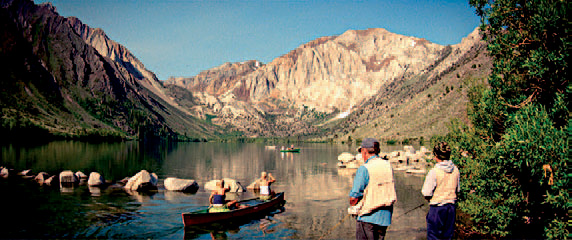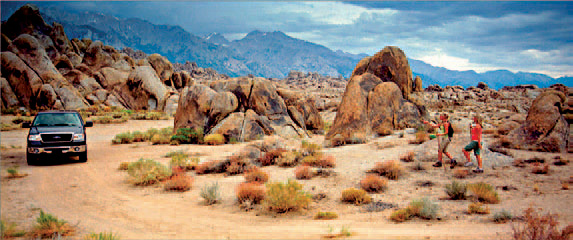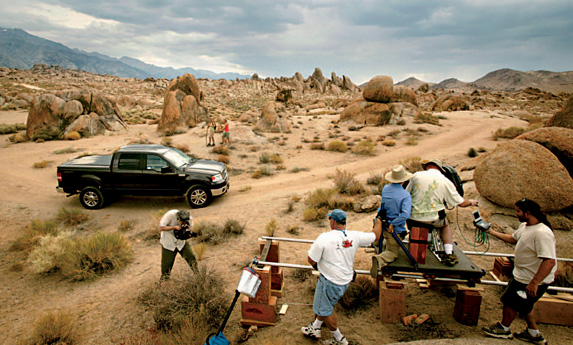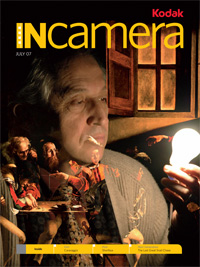"As Good as it Gets"
|
Read more
at in70mm.com The 70mm Newsletter |
| Reprintet from Kodak's InCamera, July 2007 with permission | Date: 20.08.2008 |
 "As Good As It Gets" was presented last spring to an audience of avid movie
fans during Widescreen Weekend at the National Media Museum in Bradford,
England, along with 70mm prints of classic movies from the Motion
Picture Academy of Arts and Sciences Archives. Bill Bennett, ASC traces
the origins of the short film to a conversation that he had with ARRI
Group Managing Director Franz Kraus when he visited their factory in
Munich, Germany. "As Good As It Gets" was presented last spring to an audience of avid movie
fans during Widescreen Weekend at the National Media Museum in Bradford,
England, along with 70mm prints of classic movies from the Motion
Picture Academy of Arts and Sciences Archives. Bill Bennett, ASC traces
the origins of the short film to a conversation that he had with ARRI
Group Managing Director Franz Kraus when he visited their factory in
Munich, Germany.“We were talking about the state of the industry in general,” Bennett says. “One concern that we shared was the consistent diminishment of the quality of images seen in motion picture theaters compared to the 1960s and early ‘70s. During our conversation, we realized that two generations of movie audiences have never seen 70mm projection.” Kraus suggested that Bennett design and shoot a demonstration film with the 65mm ARRIflex 765 camera that was introduced during the early 1990s. The cinematographer was also inspired by Emmanuel Lubezki, ASC, who used a combination of 65mm and 35mm formats while filming "The New World" with director Terrence Malick. Wide-angle shots were filmed in 65mm format and closeups in 35mm. “It was something you felt while watching the film on a cinema screen rather than noticing it on a conscious level,” Bennett observes. “I decided to produce a demonstration with scenes recorded on 65mm, anamorphic 35mm and Super 35 film in order to compare the impact when the images are projected in various formats.” |
More
in 70mm reading: "As Good as it Gets" - Afterthoughts “As Good as it Gets” - cast/credit "As Good As It Gets" Introductory Notes "We Fight To Be Free" Panavision and the Resurrecting of Dinosaur Technology Internet link: Kodak InCamera Magazine |
Three formats |
|
 Bennet became enarmored with cinemtography while studying theatre arts
at Trinity University in San Antonio, Texas. After completing his formal
education in 1973, Bennett moved to Los Angeles determined to become a
filmmaker. He was hired by legendary commercial director Ron Dexter, ASC,
initially as a prop man. Bennett likens his work with Dexter and later
with commercial shooter Sid Avery to graduate school. He has
subsequently filmed more than 1,000 television commercials around the
world. Bennet became enarmored with cinemtography while studying theatre arts
at Trinity University in San Antonio, Texas. After completing his formal
education in 1973, Bennett moved to Los Angeles determined to become a
filmmaker. He was hired by legendary commercial director Ron Dexter, ASC,
initially as a prop man. Bennett likens his work with Dexter and later
with commercial shooter Sid Avery to graduate school. He has
subsequently filmed more than 1,000 television commercials around the
world.Following his discussion with Kraus, Bennett developed a plan and recruited a crew and cast consisting of two young actresses. They spent three days filming sequences at scenic, exterior locations. The first sequence was filmed at Whitney Portal in the Sierra Nevada Mountains near Lone Pine, California. One scene had both actresses standing next to a waterfall. They were surrounded by a forest of pine trees. Bennett filmed wide-angle and close-up shots with matching framing in the three formats. The next scene consisted of two set-ups in the nearby Alabama Hills. One was a long dolly shot with a pickup truck driving past the performers. The other was a curved tracking dolly shot going past one of the actresses who was standing on top of a large rock. Bennett filmed establishing and close-up shots in all three formats. |
|
Stunning |
|
 The final scene was filmed at Minaret Summit near Mammoth Lakes at
sunrise with the two women hiking through a high mountain meadow with
peaks looming in the background. There are other shots of them canoeing
at nearby Convict Lake surrounded by high mountain peaks and a
stunningly beautiful sunset. The final scene was filmed at Minaret Summit near Mammoth Lakes at
sunrise with the two women hiking through a high mountain meadow with
peaks looming in the background. There are other shots of them canoeing
at nearby Convict Lake surrounded by high mountain peaks and a
stunningly beautiful sunset.Bennett says that he was especially careful in the selection of backgrounds, framing and focusing 65mm shots because every detail can be seen when the film is projected in 70mm format. FotoKem in Burbank, California, processed the negative and transferred the images to a digital file used for offline editing. The conformed 35mm negative was scanned at 4K resolution and the 65mm film at 6K resolution by ARRI Film & TV Services in Munich on ARRISCAN film scanners. Bennett heard that Kees Van Oostrum, ASC had used 65mm film for wide-angle shots and 35mm for close-ups during the production of "We Fight To Be Free", a documentary about the life of George Washington. That 22-minute film is featured in two theaters at the Visitors Center at Washington’s estate at Mount Vernon, Virginia. Van Oostrum embraced the opportunity to show 35mm and 65mm shots from "We Fight To Be Free" projected in the various formats as part of the presentation. "As Good As It Gets" was initially presented to some 300 students, faculty and filmmakers from all sectors of the industry at the University of California Los Angeles’ James Bridges Theater. It was projected in the 4K compressed digital format recommended by the Digital Cinema Initiative (DCI) sponsored by the major Hollywood studios, uncompressed 4K digital format, and on 35mm and 70mm print film. |
|
Four times more |
|
 InCamera
July 2007 edition. InCamera
July 2007 edition.“Seeing is believing,” Bennett says. “You have to judge for yourself. We could see and hear the reactions of the audience when both the 65mm shots and 70mm print film were projected on the screen. It’s not about projecting prettier pictures. It’s about the emotional connection that occurs when the audience gets pulled deeper into the film.” The presentation was capped by projecting a scene from "The Sound of Music" in 70mm format. That classic film was produced in Todd-AO 65mm format in 1965. The scene featured Julie Andrews singing the title song to the von Trapp children. They are on a grassy hill overlooking an endless horizon. “It was a stunning experience to be reminded, or see for the first time, how compelling the movie-going experience was 40 years ago,” Bennett says. “As Good as it Gets” has been taken to the next level. FotoKem has re-scanned the 65mm scenes at 8K resolution. Andrew Oran, vice president, Sales & Operations Large Format, at the postproduction facility explains that a five-perforation, 65mm wide frame has the capacity to capture more than four times more information than a four-perf 35mm frame of film composed in 2.4:1 aspect ratio. He says, “A 1,000 ft roll of 65mm negative scanned at 8K resolution will produce more than 1.4 terabytes of picture data. Film is also a proven archival medium which ensures that the movie will be there for future generations of fans.” Bennett observes, “State-of-the-art 65mm cameras and lenses are available for lower rental fees than the best 35mm film and digital equipment, and the higher raw stock and lab costs generally amount to a very small part of the budget. Kees (Van Oostrum) estimated that the higher cost for shooting about 10 percent of "We Fight To Be Free" in 65mm format was a fraction of a penny for everyone who will see the film.” He concludes, “We are on a mission to show this demonstration to as many people as possible with the hope that it will inform and inspire them" |
|
|
Go: back
- top - back issues
- news index Updated 21-01-24 |
|
